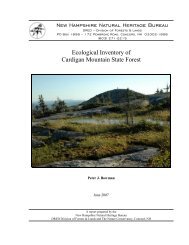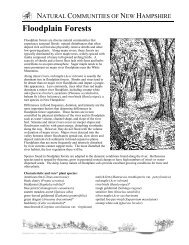Hairy Hudsonia - New Hampshire Division of Forests and Lands
Hairy Hudsonia - New Hampshire Division of Forests and Lands
Hairy Hudsonia - New Hampshire Division of Forests and Lands
Create successful ePaper yourself
Turn your PDF publications into a flip-book with our unique Google optimized e-Paper software.
RARE PLANTS OF NEW HAMPSHIRE<br />
<strong>Hairy</strong> <strong>Hudsonia</strong><br />
<strong>Hudsonia</strong> tomentosa Nutt. Synonyms: s<strong>and</strong> golden-heather<br />
Rock-rose family (Cistaceae)<br />
What Does It Look Like?<br />
A low, branched perennial shrub, usually under 20 cm (8<br />
in.) tall, forming mats or low mounds. The stems are<br />
grayish green, with whitish hairs <strong>and</strong> scale-like leaves.<br />
Older stems may be gray to reddish brown.<br />
Leaves:<br />
Flowers:<br />
Fruit:<br />
Key<br />
features:<br />
Similar<br />
species:<br />
The leaves are tiny <strong>and</strong> nearly scale-like,<br />
alternate, overlapping, blunt tipped, densely<br />
hairy, <strong>and</strong> about 1-3 mm (less than 0.12 in.)<br />
long.<br />
Five-petaled, bright yellow flowers, each<br />
about 6 mm (0.25 in.) wide, cover the tops <strong>of</strong><br />
the plants. The hairy calyx has two outer<br />
sepals that are much shorter than the inner<br />
three. Flowering occurs in late June through<br />
July.<br />
The few-seeded capsules are round, smooth,<br />
<strong>and</strong> surrounded by the calyx, which remains<br />
after flowering.<br />
Its height (very low shrubs), densely hairy<br />
leaves <strong>and</strong> stems, yellow flowers, <strong>and</strong> s<strong>and</strong>y<br />
habitat.<br />
Golden heather (<strong>Hudsonia</strong> ericoides) has slightly hairy, longer, <strong>and</strong> needlelike leaves that spread<br />
outward. The leaves are 3-6 mm (about 0.12-0.25 in.) long. Golden heather is also more greenish.<br />
Where Is It Found?<br />
In <strong>New</strong> <strong>Hampshire</strong>, hairy hudsonia is only found in s<strong>and</strong> dunes near the coast, or on s<strong>and</strong>y lake beach str<strong>and</strong>s or<br />
river barrens in the Ossipee region. Other rare species may also be associated such as golden heather (<strong>Hudsonia</strong><br />
ericoides), blunt-leaved milkweed (Asclepias amplexicaulis), <strong>and</strong> fine grass-leaved goldenrod (Euthamia<br />
tenuifolia).
RARE PLANTS OF NEW HAMPSHIRE<br />
Conservation<br />
status:<br />
Range:<br />
Why Is It Rare?<br />
<strong>Hairy</strong> hudsonia is threatened in <strong>New</strong> <strong>Hampshire</strong>. Of 19<br />
populations, 17 have been verified since 1980.<br />
Populations range from a single plant to more than 500<br />
in patches as large as 10 square m (100 sq. ft.).<br />
From Canada south along the coastal states to North<br />
Carolina, inl<strong>and</strong> from West Virginia to Illinois, <strong>and</strong><br />
north around the Great Lakes.<br />
Most coastal s<strong>and</strong> dune habitat in <strong>New</strong> <strong>Hampshire</strong> has been lost to<br />
development. Other habitats where this species is found in the state, such<br />
as s<strong>and</strong>y lake or river shores, are infrequent.<br />
Last verified<br />
#Y pre 1980<br />
#S 1980 +<br />
#S#S #S<br />
#Y<br />
#S #S<br />
#Y#S #S<br />
#S<br />
#S<br />
#S<br />
#S#S<br />
#S<br />
Conservation Considerations:<br />
While this species relies on some natural disturbance to maintain an early-successional habitat, the plants<br />
themselves are very sensitive to direct disturbance. <strong>Hairy</strong> hudsonia is easily disrupted by trampling <strong>and</strong> is<br />
especially vulnerable to vehicular traffic, which has become increasingly likely in the s<strong>and</strong>y areas where these<br />
plants are found. Restricting <strong>of</strong>f-road vehicle access, <strong>and</strong> routing foot traffic away from population areas, would<br />
help to protect this species.<br />
The information in this fact sheet is current as <strong>of</strong> December 2002. It is based on a database maintained by the NH Natural<br />
Heritage Program, a bureau in the <strong>Division</strong> <strong>of</strong> <strong>Forests</strong> & L<strong>and</strong>s in the Department <strong>of</strong> Resources <strong>and</strong> Economic<br />
Development. NH Natural Heritage is a member <strong>of</strong> NatureServe, which represents an international network <strong>of</strong> Heritage<br />
programs. Illustration by Anne Rogelberg. Reprinted with permission from The <strong>New</strong> York Botanical Garden Press.<br />
Originally published in H. A. Gleason, The <strong>New</strong> Britton <strong>and</strong> Brown Illustrated Flora <strong>of</strong> the Northeastern United States<br />
<strong>and</strong> Adjacent Canada, Vol. II, p. 548, copyright 1952, The <strong>New</strong> York Botanical Garden.<br />
To report a location for this species, or for more information, please visit our web page at<br />
www.nhdfl.org/formgt/nhiweb or call (603) 271-3623.<br />
NH Natural Heritage Program<br />
PO Box 1856<br />
Concord, NH 03302-1856<br />
Funded by the Conservation License Plate Trust Fund (the "Mooseplate").<br />
Mooseplate funds received by NH Natural Heritage are vital to developing information that leads<br />
to the protection <strong>of</strong> native plant species <strong>and</strong> natural communities.
















